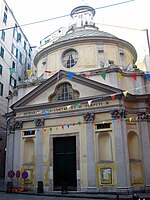Gênes
1805 establishments in the First French EmpireFormer departments of France in ItalyHistory of GenoaStates and territories disestablished in 1815States and territories established in 1805

Gênes [ʒɛn] was a department of the French Consulate and of the First French Empire in present-day Italy. It was named after the city of Genoa. It was formed in 1805, when the Ligurian Republic (formerly the Republic of Genoa) was annexed directly to France. Its capital was Genoa. The department was disbanded after the defeat of Napoleon in 1814. It was followed by a brief restoration of the Ligurian Republic, but at the Congress of Vienna the old territory of Genoa was awarded to the Kingdom of Sardinia. Its territory is now divided between the Italian provinces of Genoa, Piacenza, Alessandria and Pavia.
Excerpt from the Wikipedia article Gênes (License: CC BY-SA 3.0, Authors, Images).Gênes
Via Giovanni Bettolo, Genoa San Benigno
Geographical coordinates (GPS) Address Nearby Places Show on map
Geographical coordinates (GPS)
| Latitude | Longitude |
|---|---|
| N 44.4 ° | E 8.9166666666667 ° |
Address
Via Giovanni Bettolo
16126 Genoa, San Benigno
Liguria, Italy
Open on Google Maps











